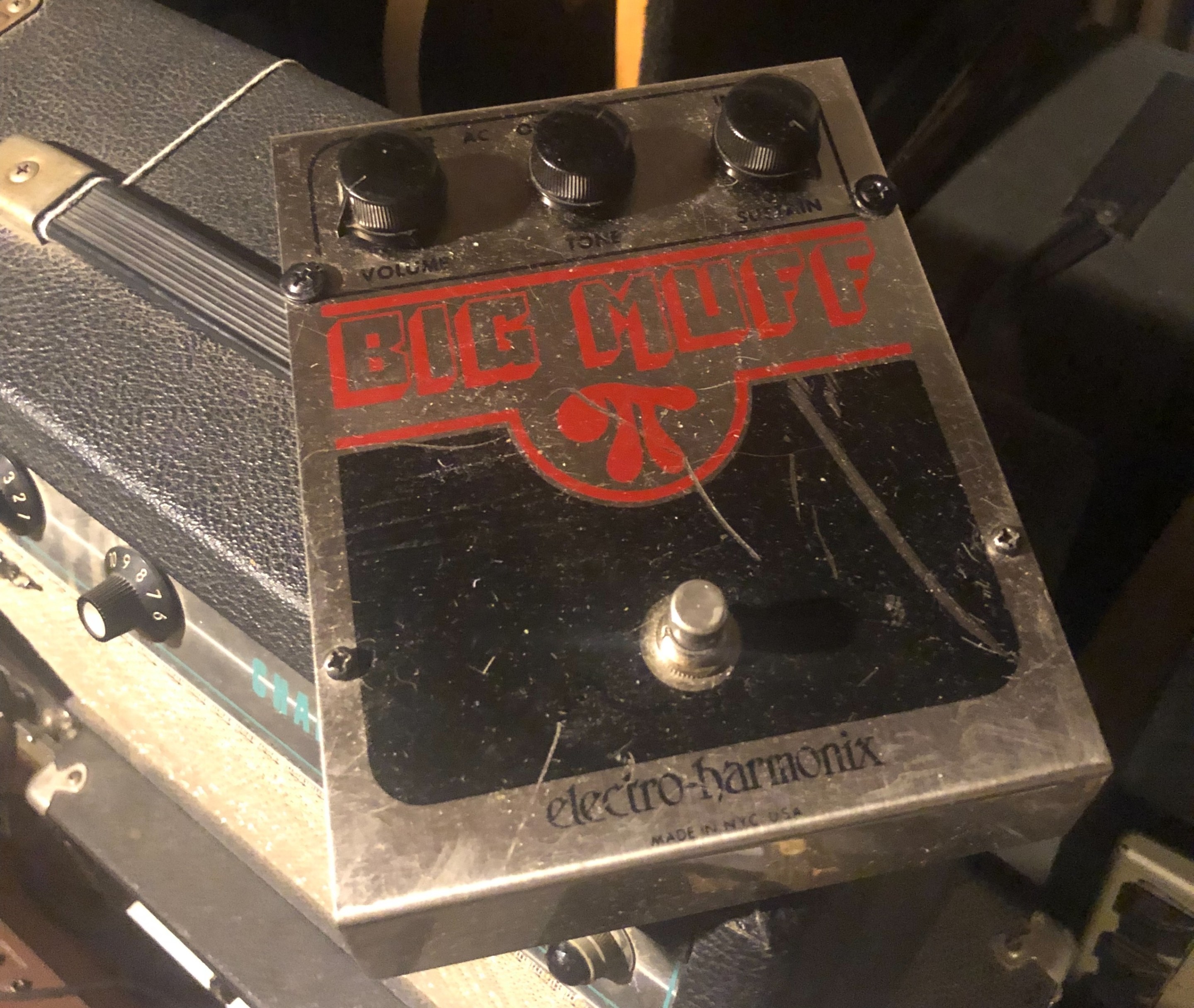“I have too many overdrive pedals!” - Me and most lousy guitarists, never.
Me and my Big Muff were recently reunited. I can’t tell you how happy that made me.
But I’ll try. A Big Muff, for all you non-guitar nerds, is an effects pedal used by musicians and studio engineers to add a distinct type of distortion to a guitar signal. Much of the allure of any particular pedal comes from what rocker’s tone came from it; the Big Muff is prized mostly because it was used by David Gilmour of Pink Floyd while recording his fuzzy-but-smooth guitar solos on The Wall, as everybody who owns one can tell you.
I own two.
The merits of a geezer with my inconsiderable musical skills owning even one Big Muff are debatable; more than one is indefensible. See, I have a problem. I quit drinking 35 years ago and began spending beer money on guitars and related toys, like amps and speakers and, worst of all, effects.
My guitarsenal now takes up so much space in my house that I “joke” that at this point I would have been better off had I just kept drinking. Pedal addiction is particularly evil because so-called stomp boxes take up so much less space than instruments or amps or speakers, and also because there’s so damn many different ones out there! I realized long ago that I have too many pedals, and also that I’ll never own enough. Now I’ve got suitcases and drawers and cardboard boxes full of them. I’ve also got a rack effects problem, a close cousin of pedal addiction. I spent last weekend in the basement wiring up a ridiculous arsenal of decades-old tube overdrives and multi-effect units in one big shelf. Push a few buttons, and this assemblage of rock electronics can turn “Kumbaya” into “Eruption.”
Effects aren’t for everybody. The Beatles, it should be noted, weren’t pedal pushers. Gearheads took to message boards to marvel about how in the new documentary about the band, Get Back, pedals get next to no play. Eagle-eyed nerds claim to have spotted a Fuzz Face, a box also stomped on in that era by Jimi Hendrix. But little else in the way of tone-enhancing implements could be spotted. (I haven’t watched much of Get Back yet, but of the scenes I’ve seen so far, nothing hit me harder than seeing John Lennon playing through an Ampeg B15 amplifier. I have two Ampeg B15s.) Then again, there weren’t that many pedals being sold in their day, and as the new doc shows these guys had sound technicians in lab coats walking around Abbey Road Studios, inventing sounds for them on request.
My buddy Eli, who despite being a total musical genius plays guitar in the same shitty band I’ve long been in, shuns pedals. He blames his distaste for gizmos on a VHS tape he rented as a lad, featuring Adrian Belew, the avowed guitar wizard beloved by axe nerds for his work with King Crimson and Frank Zappa. “I thought it was going to be instructional, but the whole video was him saying, ‘Here’s the rack of effects I used to get this sound!’ and ‘Here’s the $900 piece of equipment I used to get that sound!’” Eli tells me. “I just wanted to hear how he plays what he plays!”
But let those with musical gifts and sound technicians in lab coats turn their nose up at pedals. That leaves more more more for me me me. (When I heard that Inner Ear, the studio where all the legendary D.C. punk bands plus my shitty band recorded was closing, I went to say goodbye to its iconic owner and chief engineer, Don Zientara. I came home with an EHX B9 Organ Machine, a quasi-synthesizer that can make your every note sound like it’s coming from a church choir; Fugazi and Bad Brains, among the acts Zientara produced, never played guitars to sound like church choirs. But the pedal was there.
I got my first Big Muff for $5 at a yard sale early into my hoarding. I used it fairly regularly back early into ownership during roaring solo shred sessions in my apartment, but put that Big Muff in its box and hadn’t seen it in years. I got the second Big Muff maybe a decade ago off a classified ad just because, and after making sure it worked properly, never played through that one again. But I lost track of one of them at some point years ago, and was bothered by how bothered its disappearance made me. While looking through my piles of stuff for rack units over the holidays, I stumbled upon a grocery bag that contained a vintage MXR Distortion+ pedal (just like the one Bob Mould used in Husker Du!), an EHX Small Clone pedal (the very phaser pedal that Kurt Cobain used to make wavy noises on “Come As You Are”!), a first-generation MXR117 flanger (with the Reticon SAD1024 chip, just like the one Eddie Van Halen used on “And The Cradle Will Rock”!), and, most gloriously, my long-missing Big Muff! What a haul!
I plugged them all in and dusted off my favorite Mould and Cobain and Gilmour licks and was in shredder heaven. (The flanger was dead, so no EVH riffs were summoned.)
Along with losing track of bags of gear, a sure sign of pedal addiction is that the pleasure derived from any one tone, no matter how glorious, is very temporary. Hoarders reach an absolute inability to stay aurally monogamous. Before even one afternoon of being reunited with my Big Muff was over, I was back on Craigslist in search of more toys. I ended up trading an almost disposable Bugera practice amp for cash and an Ibanez Tube Screamer, a vintage overdrive pedal that’s been sought after since Stevie Ray Vaughan got caught using one.
I paired my latest flame with a beat-up tube amplifier fashioned out of the guts of a 1950s Bogen record player and played bloozy shuffles for hours. This is my fourth Tube Screamer. I can’t tell you how happy it made me!






